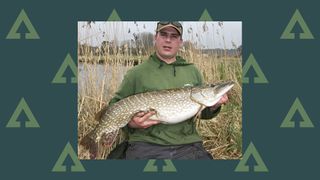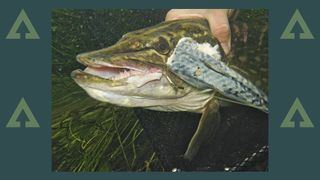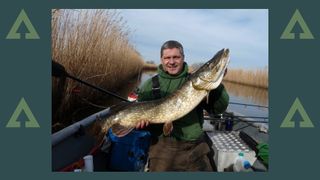How to find big pike: top tips for fishing on rivers
Want to know how to find big pike? Alan Dudhill, of the Pike Anglers’ Club of Great Britain, gives his tips for fishing on rivers

Welcome to Advnture, the new home of AnglersMail.co.uk
If you want to know how to find big pike, then you need to be fishing on rivers. Don't worry if you don't know where to start though because Pike Anglers’ Club of Great Britain's Alan Dudhill is on hand to share his top tops on how to find big pike.
Understanding the behaviour of river pike will greatly improve your catch rate and big pike are rarely far from their next meal, either waiting in ambush or holding prey into a feature to attack at will.
- The best fishing spots: how to find the perfect place to go fishing
- How to unhook pike: unhooking fish safely
- How to plan a fishing trip: all you need to know before you go
Overhanging trees with submerged roots provide the perfect habitat for ambush predators. Bridges and other structures give cover to prey fish such as roach, particularly in the winter where they may form huge shoals.
Some areas may consist of a combination of features such as a weir, outlet or junction. These are the ’hotspots’ which are likely to hold a good head of fish all year round and are perfecting for finding big pike.
A mobile approach will give the best results. If using deads, move on every half hour or so but extend this to an hour if you catch. Other pike may well be in the same area. Read on for more top tips on how to find big pike.

How to find big pike: bigger baits can really score
Pike are rarely found fighting the full current as it’s too much like hard work for this somewhat lazy fish. However, they often use the current to their advantage to effortlessly swim downstream to the next ambush point.
Advnture Newsletter
All the latest inspiration, tips and guides to help you plan your next Advnture!
They much prefer to sit in slack water alongside the main flow to pick off passing prey which are caught in the turbulence.
Drops-offs provide good river habitat, where the pike can lay at the bottom of the ledge to avoid the strong current but still be in the main river.
River pike in particular, will not waste valuable energy chasing a small meal. The nourishment gained would be less than the energy exerted in catching it.
This is why they are renowned for taking large baits in obvious preference to smaller ones in fast flowing rivers such as the Idle or Trent.
I prefer to use whole mackerel, sardines and lamprey of at least a foot long and make up special traces for these larger baits.

How to find big pike: spotting underwater features
Rivers have many underwater features, which can be easily discovered by observing features above the water line and utilised to help you learn how to find big pike.
As a river meanders, it lifts silt from the outside of bends, creating deeper channels and depositing silt on the inside of the bends to create shallow areas. Often the deeper channels will hold resident pike, laying on the bottom to ambush prey which passes above.
Underwater features such as deep holes and ledges can be found by plumbing the depths and this can easily be done by counting down a bait till it hit’s the bottom. This will give you a rough idea of the contours of the river bed so you can select a likely spot to drop a bait to.
Any areas of slack water are prime places to find big pike. Whether a bay set aside from the main flow, adjoining dyke, rear of an island or behind a man-made structure, these features create the perfect slack water where pike like to lurk.
Back eddies are also prime spots, where the river swirls to form a slower paced current, which is heading in the opposite direction.
Running from 1964 until 2020, Angler's Mail was the UK's leading weekly magazine devoted to coarse fishing, telling readers everything they needed to know about which fish to catch, where to catch them, and what kit they needed to do it. Now, loads of the magazine's expert advice can be found on Advnture.com, as a helpful resource for angling newcomers and experts alike.
Most Popular

